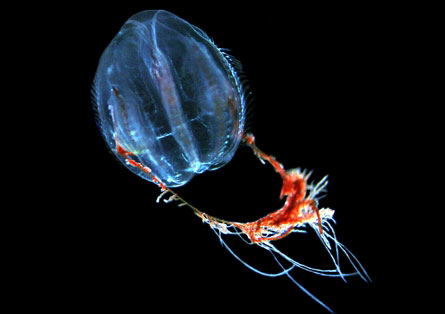Introduction
Animals are multicellular eukaryotic organisms that belong to the Kingdom Animalia. Every animal has distinct traits. They get their energy either from plants or from other creatures. Millions of species have been recognized, with some sharing similar features and others differing dramatically.
The traits of animals are used to classify them. They are found in algae, plants, and fungi when solid cell walls do not exist. Some are also heterotrophic, digesting their food within internal chambers, which distinguishes them from algae and plants. Another distinguishing feature of these species is their mobility, especially during particular life phases.
Have you ever snorkeled in the deep water and come across a lightning-clear critter that looks like a jellyfish and reflects a stunning rainbow-like effect? Ctenophores resemble jellyfish but do not belong to the Phylum Cnidaria. These species are members of the Phylum Ctenophora. This Phylum is not as well known as other animal kingdom species.
Ctenophores are soft-bodied, free-swimming marine animals having biradial symmetry and comb-like ciliary plates for movement. They are devoid of nematocytes. They are also known as sea walnuts or comb jellies.
Members of this Phylum are exclusively aquatic creatures that live on the ocean’s surface or at its bottom. Comb Jellies are another name for them. This article will provide previously discovered information about the Phylum Ctenophora.
Definition of Ctenophora Phylum
Comb jellies are another name for Phylum Ctenophora. This Phylum is made up of bi-radially (radial + bilateral) symmetrical marine water invertebrates, most of which are transparent and colorful. This Phylum’s species are mostly found in aquatic habitats and do not live in freshwater. Animals in this Phylum include the Sea Walnut, Sea Gooseberries, Venus Girdle, and others.
Classification
Ctenophores are classified into two groups and many orders based on their body shapes and features Ctenophora is split into two groups based on the presence or lack of tentacles.
Class-1 Tentaculate is a class of organisms that have tentacles.
Class-2 Nuda means without tentacles.
Characteristics
These species are only found in the sea.
This Phylum’s animals are solitary and free swimming.
They have a diploblastic acoelomate body structure. The body is translucent, gelatinous, soft, and segmented, with two long, solid, retractile tentacles.
Body Symmetry: These species have a bi-radial symmetry.
Tissue: Tissue-level organization is seen in these invertebrates.
They move by using eight strips of cilia called comb rows. These comb-like rows aid in movement.
Reproduction happens through sexual methods because they are hermaphrodite animals.
External fertilization and indirect development are used by these species.
They have both an external and an intracellular digestive system.
For balance, they have an aboral sensory organ called the statocyst.
Respiration and excretion: They lack distinct organs for respiration and excretion, and the body surface is responsible for both.
Size and shape range from microscopic Phylum Ctenophora spheroids (0.04 inch) to lengthy (4.9 foot) ribbons. Ctenophora are lobe-shaped animals.
Economic Importance
They create stunning vistas while diving and snorkeling.
One advantage of Ctenophora was its genetics. The light created quickly by Ctenophores is employed as a “biomarker” or “biotag.”
Scientists employ them in studies to uncover activation genes by making various luminous cats, mice, and other animals and determining if the genetic alterations made to these animals are functioning.
Ecological Importance
They reproduce fast and are effective predators, so they keep the plankton population under control.
They may hunger and shrink when food is scarce, and they can adapt to higher temperatures, giving them an edge in changing climatic conditions.
Comb Jelly (Pleurobrachia sp.)
Comb jellies are part of a small phylum allied to the cnidarians and similar to them in many ways. They are radially symmetrical like a cnidarian medusa, the body is mostly water, and they capture their prey in a somewhat similar manner with tentacles. But there are many differences.
Comb jellies can be seen floating around near the surface of Puget Sound and other Pacific Northwest waters. Pleurobrachia are about 1.5 cm in length and egg-shaped, with a mouth at one end (oral) and anal pores at the other (aboral). Two long (as much as 15 cm) tentacles extend from and can be retracted into sheaths near the aboral end. Along the body axis run eight ciliated bands (comb rows) that provide the comb jelly’s locomotion and give it its name.
Instead of stinging nematocysts on their tentacles, ctenophores have colloblasts, rather complex structures that produce a glue that sticks to the animals they capture for food. This is the same fishing method as that used by cnidarians but obviously independently evolved. However, one kind of ctenophore does use nematocysts rather than colloblasts, making certain the origin of ctenophores from cnidarians.
The digestive tract is a complex series of meridional canals running along the periphery and from them inward to the central digestive canal. Digested food can be excreted through the mouth or anal pores.
Pleurobrachia and other comb jellies have a statocyst, a visible balancing organ at the aboral end. This organ contains a solid structure called a statolith that sits in a pit surrounded by four patches of balancer cilia. When the animal is tilted, the statolith contacts one of the patches, and a neural signal is sent to tilt it back up to its “upright” position by differential beating of the comb rows. The animal also has additional control of its positioning, for example turning the mouth toward a tentacle with captured prey.
Unlike cnidarians, ctenophores are hermaphrodites, with both sexes in the same individual. The gonads are separate, a set of testes and ovaries in each. Eggs and sperm are shed to the outside through the mouth. The larva that develops from fertilized eggs looks much like a small version of the adult in this species.
One of the special features of some comb jellies is the rainbow effect of their comb rows when seen in a bright light. The movement of the cilia scatters light in such a way to cause this effect; it is not bioluminescence.





